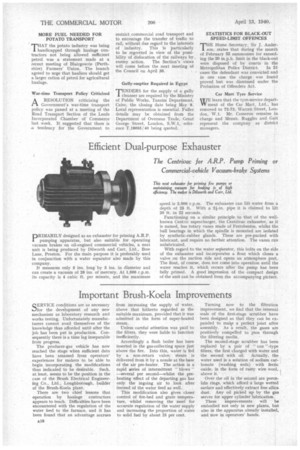Efficient Dual-purpose Exhauster
Page 20

If you've noticed an error in this article please click here to report it so we can fix it.
The Centrivac for A.R.P. Pump Priming or Commercial-vehicle Vacuum-brake Systems
DRIMARILY designed as an exhauster for priming A.R.P. pumping apparatus, but also suitable for operating vacuum brakes on oil-engined commercial vehicles, a neat unit is being produced by Dilworth and Carr, Ltd., Bow Lane, Preston. For the main purpose it is preferably used in conjunction with a water separator also made by this company.
It measures only 5 ins, long by 3 ins, in diameter and can create a vacuum of 26 ins, of mercury. At 1,000 r.p.m, its capacity is 4 cubic ft. per minute, and the maximum
speed is 2,000. r.p.m. The exhauster can lift water from a depth of 25 ft. With a 24-in, pipe it is claimed to lift 20 ft. in 22 seconds.
Functioning on a similar principle to that of the wellknown Centric supercharger, the Centrivac exhauster, as it is named, has rotary vanes made of Ferrobestos, whilst the ball bearings in which the spindle is mounted are isolated by synthetic-rubber glands. These are pre-packed with lubricant, and require no further attention. The vanes run unlubricated.
With regard to the water separator, this bolts on the side of the exhauster and incorporates a float which closes a valve on the suction side and opens an atmosphere port. The float, of course, does not come into operation until the water reaches it, which occurs after the pump has been fully primed. A good impression of the compact design of the unit can be obtained from the accompanying picture.




















































